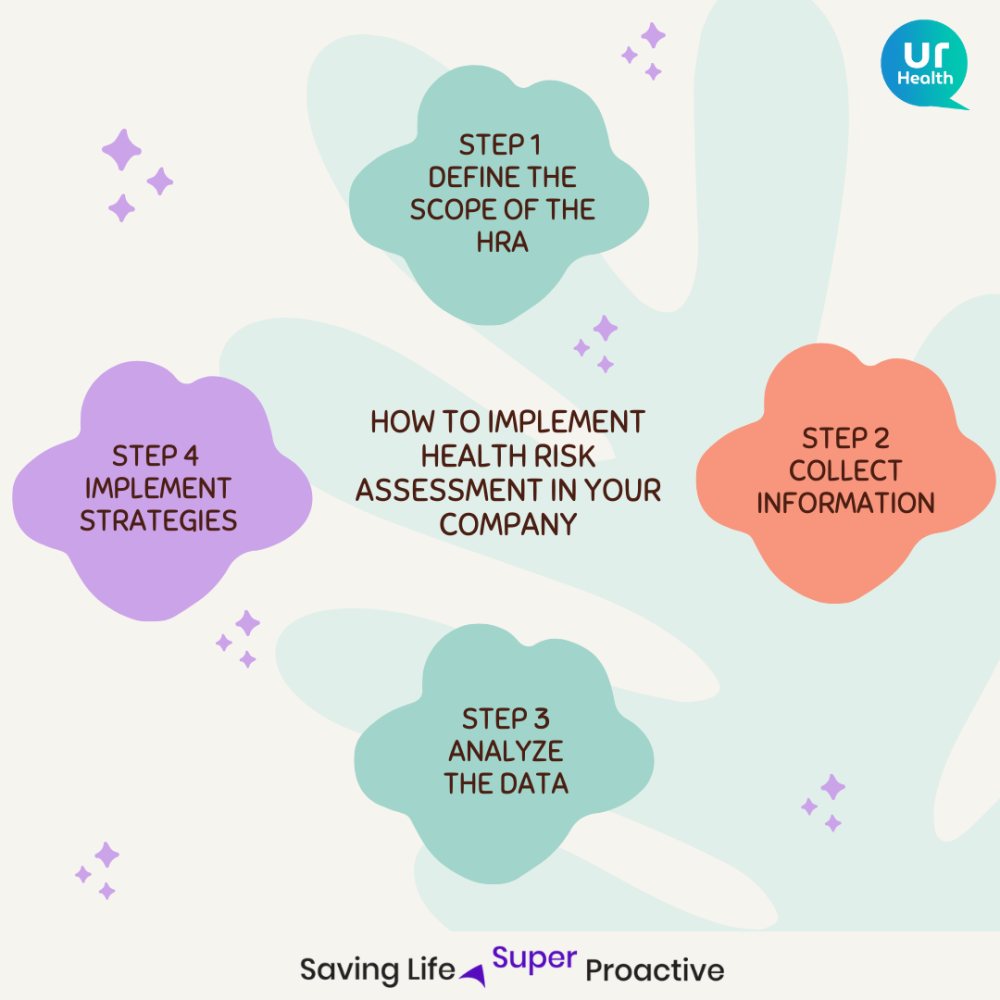We live in our bodies. We push them, we stretch them, and sometimes we forget how much we rely on them until something goes wrong.
In the workplace, where we spend much of our lives, it becomes intertwined with performance, deadlines, and the pressure to keep going, often at the cost of our well-being. But the truth is, none of us are immune to the toll that work, stress, and life’s wear and tear can take on our bodies and minds.
A Health Risk Assessment (HRA) is one of the few moments when we step back and ask: How are we doing, really? What might our bodies be telling us that we haven’t yet heard?
For companies, this is a chance not just to take stock of employee health for the sake of reducing costs but to create an environment where people are seen as more than workers. These assessments can be a step toward this. Recognizing the whole person, what drives them, what drains them, and what issues might be quietly going unnoticed.
What is a Health Risk Assessment?
A health risk assessment (HRA) is essentially a structured evaluation of an individual’s health status. It involves collecting both objective data, like biometric screenings, and subjective information, like how someone feels day to day. This data offers insight into chronic disease risks, workplace stressors, and lifestyle habits that don’t always get addressed in a routine check-up.
The Role of Health Risk Assessments in the Workplace
Company health risk assessments are often seen to minimize healthcare costs, but their true value goes beyond dollars saved. Well-executed, it offers employees something rarely afforded in the rush of work: It gives companies a chance to listen—really listen—to what their workforce is going through.
This is particularly important when we think about “key man risk” — high-performing individuals or specialists whose absence could disrupt the entire organization. These assessments then become indispensable to get ahead of this risk, not just by simply identifying potential health problems but also by offering support that keeps these essential players healthy.
It’s easy to look at health risk assessments as a somewhat mundane part of corporate health services. But businesses that truly take them seriously and act on their findings in a way that is purposeful tend to reap benefits far beyond reduced healthcare costs. We’ll go into more detail about the benefits below.
What Does a Health Risk Assessment Include?
The components of a health and risk assessment may seem clinical, but each piece offers a window into someone’s life. When combined, these insights can form actionable strategies to improve employee health and well-being.
1. Hazard Identification
Every assessment starts with the basics: identifying potential hazards. These could stem from personal health histories or from the work environment itself. Chronic disease risks such as hypertension or diabetes don’t always announce themselves loudly—oftentimes, they manifest in subtle ways that can be overlooked for years. However through a detailed evaluation, these risks can be identified early. Similarly, work-related hazards—whether physical strain or prolonged stress—can also be flagged before they become debilitating.
2. Workplace-Specific Risks
Some risks are unique to certain jobs, and each job will come with its own set of challenges. Whether it’s ergonomic concerns, exposure to hazards, or high-stress conditions, a comprehensive assessment will take all these into account.
3. Risk Evaluation
The next step is evaluating how likely and severe those risks are. Which ones need immediate attention? Which can be monitored and managed with time? This process helps prioritize interventions, ensuring that resources are used where they’re needed most. The idea here is to keep the future in mind while also addressing the present.
4. Biometric Data Collection
Numbers can often reveal what we cannot. Blood pressure, cholesterol levels, body mass index, glucose readings—these metrics are important markers of health. Gathering this biometric data gives a clearer, more objective picture of an individual’s health. It also provides a baseline from which progress can be measured. For example, elevated blood pressure might point to stress or lifestyle factors; high cholesterol might hint at dietary patterns that need attention.
5. Behavioral and Lifestyle Data
Where biometric data tells us what it is, behavioral and lifestyle data tells us why. It’s a space where employees can share their daily habits—what they eat, how they move, if they smoke, and how much alcohol they consume. This adds color to the picture, helping us understand the behaviors that shape their health by adding depth to the numbers and offering context. This layer of information allows businesses to create or adjust their wellness programs in a way that addresses both the measurable and the behavioral elements of health.
6. Personalized Feedback
The next step is to make sense of all the information gathered and offer something practical, giving each individual clear, actionable steps to improve their health. For one individual, this might mean recommending an exercise routine to boost physical activity; for another, it could involve developing a detailed plan to manage a chronic condition. The aim is to provide guidance that is specific and achievable.
7. Mental and Emotional Health Screening
In many ways, the mind carries just as much weight as the body when it comes to health. Stress, anxiety, depression—these can be hidden in plain sight, slowly eroding a person’s ability to function at their best. Risk assessments for mental health help to catch most issues before they escalate. Here, businesses can begin to take proactive action, such as offering support through counseling, wellness programs, or even just creating an open dialogue about mental health in the workplace.
8. Follow-Up and Monitoring
As with any plan, the key is follow-up and follow-through. While these assessments provide a baseline and an action plan, ongoing care, and regular check-ins ensure that health strategies stay on track. Telemedicine can be a powerful tool here, offering regular follow-up without disrupting the workday.
What to Expect from the Health Risk Assessment Questionnaire
Every assessment will begin with an extensive questionnaire. Here employees are asked about various aspects of their health and lifestyle that, together, give a fuller understanding and a starting point of where they are physically and mentally. Typically, it includes:
- Medical History: Questions about chronic disease history, surgeries, and family medical background.
- Lifestyle and Behavioural Habits: Questions about exercise frequency, dietary habits, alcohol consumption, and smoking.
- Mental Health and Emotional Well-Being: Questions about stress levels, symptoms of anxiety or depression, and overall emotional health.
- Work Environment Risks: Questions about exposure to high-stress environments, physically demanding work, and other workplace-specific risks.

How Often Should These Assessments Take Place?
Health, like most things, is not static. Just as one would check in on financial reports or project deadlines, the same regularity should apply to assessing health. For most companies, annual assessments provide enough insight to track trends and intervene early enough.
However, higher-risk employees or those in physically demanding jobs may benefit from more frequent assessments—every six months, for example. The frequency can and should be adjusted based on the specific needs of the workforce and/or industry regulations. Once again, it’s all about consistency, ensuring that health remains a priority over time.
Challenges and Solutions.
Getting employee buy-in is, unfortunately, a common hurdle. As with anything that involves personal health, there can be hesitation or concern. Employers often face reluctance from employees for a variety of reasons, but these challenges can be met with thoughtful solutions that respect individual needs and priorities.
Challenge 1: Privacy Concerns
One of the most common reasons employees shy away from participating is the fear that their private health data may not remain confidential. The idea of sharing personal health information with their employer or having it recorded somewhere accessible can be unsettling.
Solution: Clear, transparent communication about how the data will be used, coupled with strong privacy protections, can ease these concerns. Companies must reassure employees that their information will remain confidential and that the assessments are designed solely to benefit them.
Challenge 2: Lack of Awareness
Some might not fully grasp the value. For some, it may seem like just another task or a formality with no tangible benefits. If they don’t understand how the results can lead to real health improvements or workplace adjustments, partaking may seem pointless.
Solution: Providing education in a meaningful and relatable way about the benefits, including potential health improvements and the opportunity for personalized feedback, can increase engagement.
Highlighting success stories, offering incentives, and framing assessment as an act of care rather than a formality helps shift the perception and encourage participation.
Challenge 3: Time Constraints
For those in more demanding roles, time is often a barrier, and finding the time to complete such an extensive assessment properly can feel like an additional burden in an already packed schedule.
Solution: Offering flexible options for completing the assessment, such as through mobile apps or during designated wellness days, can make participation easier and more convenient.
Challenge 4: Fear of Negative Outcomes
Employees might avoid them because they’re afraid of what the results will show. They may fear that being labeled as “high risk” could lead to workplace discrimination.
Solution: Businesses should emphasize and reassure that the objective is to provide support, not judgment. Communicating clearly that the results are confidential and will not be used against them can help alleviate these concerns.
Challenge 5: Concerns About Data Accuracy in Self-Reporting
Self-reported data can sometimes be incomplete or inaccurate. Whether intentional or not, employees may underreport unhealthy habits or overlook details that seem insignificant to them.
Solution: Encourage honesty by framing the assessment as a tool for personal well-being, not as something used for performance evaluations. Pairing self-reported data with biometric screenings also helps balance the subjective with the objective, ensuring a fuller, more accurate picture of employee health.
Key Benefits for Employers
While the primary focus of a health risk assessment is the well-being of employees, the benefits to employers are also ample.
1. Reduction in Healthcare Costs
By identifying potential health issues early, companies can implement preventive measures that may reduce the need for costly treatments later.
2. Improved Employee Productivity and Engagement
As mentioned, healthier employees are often more engaged and productive. Addressing health concerns can enhance overall performance and job satisfaction.
3. Enhanced Corporate Wellness Programs
Data from these assessments informs the development of wellness programs that resonate with employees’ actual needs, making these initiatives more effective.
4. Increased Employee Retention and Recruitment
Demonstrating a commitment to employee well-being can make a company more attractive to both current and prospective employees.
5. Regulatory Compliance and Risk Management
They help ensure compliance with health regulations and support executive health risk management by identifying potential issues before they become critical.
At WorldClinic, our concierge medical services go a step further by offering 24/7 access to board-certified doctors and continuous care coordination through telemedicine. We focus on proactive, preventive care that supports employees every step of the way, ensuring they receive the highest level of health support and advocacy. This goes beyond standard assessments, offering a full spectrum of care that addresses both immediate and long-term health needs.
Conclusion
As we can see, health risk assessment is so much more than just a health screening—it’s a reminder that we’re not machines that can run endlessly without care.
For businesses, the choice to offer initiatives like these is a choice to recognize that employees are people with bodies, minds, and lives that extend far beyond the office. It’s about encouraging a culture that values health as much as it values productivity, because in the end, the two aren’t separate—they’re deeply connected.
And with the right support, like the corporate health services from WorldClinic, businesses can provide ongoing care that meets employees where they are, with tools that are accessible and personalized.
What are the 4 things a health risk assessment should include?
A health risk assessment typically includes lifestyle factors, biometric data, medical history, and a mental health evaluation.
What is the health risk assessment score?
The health risk assessment score is a numerical representation of your overall health risks. It’s derived from the data collected during the assessment and can help prioritize areas for improvement.
What are common health risk factors?
Common health risk factors include smoking, poor diet, lack of physical activity, high blood pressure, and excessive alcohol consumption.
What are some examples of workplace health risks?
Workplace health risks can vary depending on the environment but commonly include ergonomic risks, exposure to hazardous materials, stress, and mental health issues.


